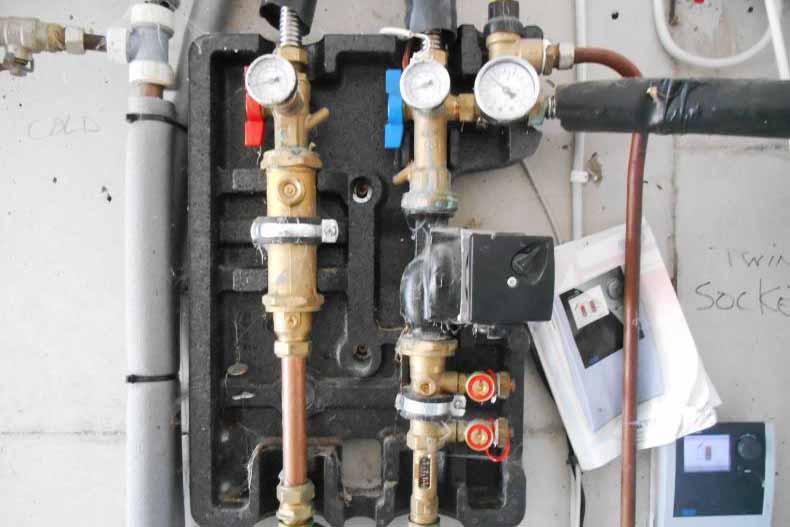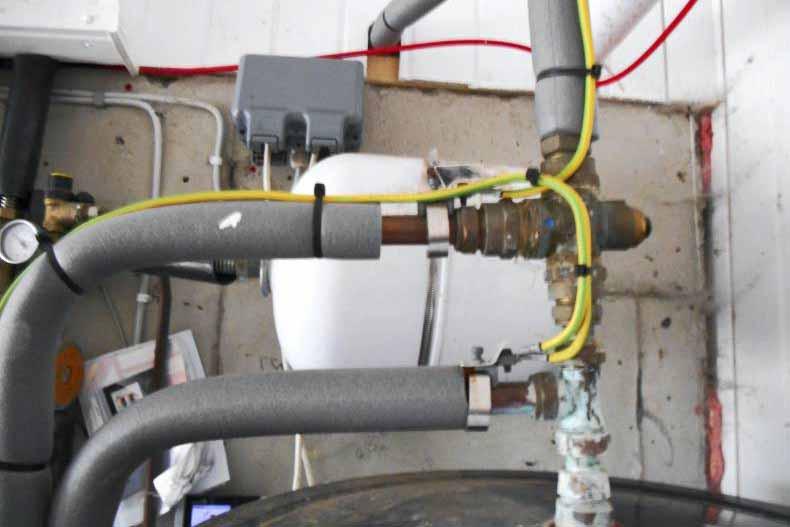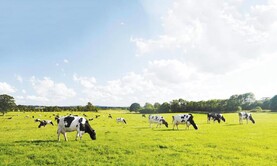Usually, in new dairy parlour installations, farmers and advisers tend to talk about the size of the milking machine, the size of the bulk tank and the extras that can be put in, such as automatic cluster removers (ACRs) and automatic feeders, but little thought is given to hot water requirements. This Kilkenny farmer installed a solar system to heat his water and had a three-year payback.
The dairy end of the parlour doesn’t normally receive the same level of attention and consideration. I recently visited a new entrant’s dairy farm in south Kilkenny. The farmer converted to dairying three years ago and used to run a suckler herd prior to this. He is milking 60 cows and has a tidy and well-designed set up. This farmer was aware that he was going to need a good supply of hot water to clean the milking equipment and bulk tank. He decided to install a solar system to heat the water in an effort to reduce his dependence on bought-in electricity.
South East Milking Machine and Dairy Services Ltd in Co Kilkenny installed the solar water heating system for the farmer. Company director Greg Power showed me how the system works.

Picture one
This is the shed into which the new 12-unit Pearson parlour is fitted. On top of the parlour roof, a 40-tube solar panel is in operation.
Greg usually installs vacuum tubes rather than flat plates because he feels tubes can capture more sunlight. The tubes were installed facing south and at an angle to maximise the amount of sunlight exposure. Inside the tubes, a copper conductor collects the solar energy. A special fluid called glycol passes through the tubes; the heat from the copper conductor transfers to the fluid. The hot fluid then flows down to the parlour and enters a coil at the bottom of a hot water tank.
As the water in the tank is cooler than the solar fluid, heat is transferred from the solar system to the water in the tank.


Pictures two and three
This is the 300-litre insulated water tank. Greg says that the water inside this tank is maintained at a minimum of 70°C. There is an immersion heater and element in the tank, which kicks in if the temperature of the water falls below 70°C. This is needed during times when the weather is dull. Picture three shows the pumping station that circulates the glycol fluid through the solar tubes and back down to the coil in the water tank.
Greg says solar-heated water is ideal for a spring-calving herd. He explains that sunlight is an essential element for the system to work. “It could be freezing outside but once there is light getting to the tubes the water will be heated,” says Greg.
The reason he thinks it is ideal for a spring-calving herd is because the timeframe when hot water is needed most (February to late October) also coincides with the period that solar heating is at its optimum. November to January are the shortest days of the year and usually the least productive for the solar heating system. During the summer, the majority of the hot water is heated by the solar system, according to Greg.


Pictures four and five
Some of the pipes coming from the tank have mixing valves installed. This enables cold water to be mixed with warm water. A thermostatic valve then regulates the temperature of the water going to the different areas.
The top pipe, for example, leads to a handheld hose for the parlour pit.
The farmer uses this to clean off the outside of clusters and any cows with dirty teats.
The mixing valve and thermostat means that the temperature of the water going to the handheld hose isn’t too hot to use.

Picture six
There are two wash tanks. One is fed hot water from the tank while the other holds cold water.
After milking, the farmer places the black pipe (pictured hanging between two tanks) into the cold water tank and uses this cold water to rinse out the milking machine.
He then switches the pipe and uses the hot water wash tank to finish the job.
Having the option of cold water for the initial rinse helps to conserve the hot water supplies.

Greg Power says that more and more farmers are becoming interested in solar hot water heating systems.
The solar hot water system on this farm including the 40 tubes, the 300-litre hot water tank and piping, costs €4,998. This includes VAT and installation (Figure 1).
The 40 tubes cost €1,700, the cylinder cost €800 and the remaining €2,500 covered the costs of piping and installation.
Greg says that if this farmer was dependent on electricity to heat his hot water for his 50-cow herd, it would cost €600 every two months (€3,600 per year). With the solar installation, the farmer is cutting his electricity bill by half because the electricity is now only being used when there isn’t enough heat coming from the tubes. With solar, his electricity bill would be €1,800 per year.
With the reduced bill, Greg says the payback period for this farmer is just three years.
This farmer also plans on installing a solar water pump to service the troughs in the paddocks.
According to Greg, running costs for the solar system are low.
Typically, a farmer would only have to service the system every two years. He says that this service usually costs €100.
The service consists of replacing the glycol in the system, checking that the temperature probes are working correctly and the circulation pump is functioning appropriately.
For a farmer with an existing parlour, a solar system can be easily retrofitted and incorporated to the parlour. Greg says that the tubes are capable of bringing the tank to boiling point on a clear day. The system has a lifespan of 25 to 30 years if maintained properly.
He uses a hot wash twice a day to clean the inside of the milking equipment and he also uses a handheld hose to clean some cows and the outside of clusters with lukewarm water. The payback period depends on the amount of hot water you use. Some farmers will only use a hot wash for their parlour once a day every day while others will use it every second day and some might only use hot water once a week.
Greg has tips for farmers trying to reduce costs in their new or existing dairy:
Carefully consider how you will heat your water. Remember you need a good supply of water over 70°C that will kill bacteria. Greg says that solar power is a very real option for farmers that want an affordable and constant supply of hot water. The source of the water for washing down the parlour. Parlours require big quantities of water for washing down and harvesting water from shed roofs may help to reduce costs.Cooling milk before it gets to the bulk tank can significantly reduce costs. Greg says that all farmers should consider installing a plate cooler to reduce the work the refrigerated bulk tank has to do.
Usually, in new dairy parlour installations, farmers and advisers tend to talk about the size of the milking machine, the size of the bulk tank and the extras that can be put in, such as automatic cluster removers (ACRs) and automatic feeders, but little thought is given to hot water requirements. This Kilkenny farmer installed a solar system to heat his water and had a three-year payback.
The dairy end of the parlour doesn’t normally receive the same level of attention and consideration. I recently visited a new entrant’s dairy farm in south Kilkenny. The farmer converted to dairying three years ago and used to run a suckler herd prior to this. He is milking 60 cows and has a tidy and well-designed set up. This farmer was aware that he was going to need a good supply of hot water to clean the milking equipment and bulk tank. He decided to install a solar system to heat the water in an effort to reduce his dependence on bought-in electricity.
South East Milking Machine and Dairy Services Ltd in Co Kilkenny installed the solar water heating system for the farmer. Company director Greg Power showed me how the system works.

Picture one
This is the shed into which the new 12-unit Pearson parlour is fitted. On top of the parlour roof, a 40-tube solar panel is in operation.
Greg usually installs vacuum tubes rather than flat plates because he feels tubes can capture more sunlight. The tubes were installed facing south and at an angle to maximise the amount of sunlight exposure. Inside the tubes, a copper conductor collects the solar energy. A special fluid called glycol passes through the tubes; the heat from the copper conductor transfers to the fluid. The hot fluid then flows down to the parlour and enters a coil at the bottom of a hot water tank.
As the water in the tank is cooler than the solar fluid, heat is transferred from the solar system to the water in the tank.


Pictures two and three
This is the 300-litre insulated water tank. Greg says that the water inside this tank is maintained at a minimum of 70°C. There is an immersion heater and element in the tank, which kicks in if the temperature of the water falls below 70°C. This is needed during times when the weather is dull. Picture three shows the pumping station that circulates the glycol fluid through the solar tubes and back down to the coil in the water tank.
Greg says solar-heated water is ideal for a spring-calving herd. He explains that sunlight is an essential element for the system to work. “It could be freezing outside but once there is light getting to the tubes the water will be heated,” says Greg.
The reason he thinks it is ideal for a spring-calving herd is because the timeframe when hot water is needed most (February to late October) also coincides with the period that solar heating is at its optimum. November to January are the shortest days of the year and usually the least productive for the solar heating system. During the summer, the majority of the hot water is heated by the solar system, according to Greg.


Pictures four and five
Some of the pipes coming from the tank have mixing valves installed. This enables cold water to be mixed with warm water. A thermostatic valve then regulates the temperature of the water going to the different areas.
The top pipe, for example, leads to a handheld hose for the parlour pit.
The farmer uses this to clean off the outside of clusters and any cows with dirty teats.
The mixing valve and thermostat means that the temperature of the water going to the handheld hose isn’t too hot to use.

Picture six
There are two wash tanks. One is fed hot water from the tank while the other holds cold water.
After milking, the farmer places the black pipe (pictured hanging between two tanks) into the cold water tank and uses this cold water to rinse out the milking machine.
He then switches the pipe and uses the hot water wash tank to finish the job.
Having the option of cold water for the initial rinse helps to conserve the hot water supplies.

Greg Power says that more and more farmers are becoming interested in solar hot water heating systems.
The solar hot water system on this farm including the 40 tubes, the 300-litre hot water tank and piping, costs €4,998. This includes VAT and installation (Figure 1).
The 40 tubes cost €1,700, the cylinder cost €800 and the remaining €2,500 covered the costs of piping and installation.
Greg says that if this farmer was dependent on electricity to heat his hot water for his 50-cow herd, it would cost €600 every two months (€3,600 per year). With the solar installation, the farmer is cutting his electricity bill by half because the electricity is now only being used when there isn’t enough heat coming from the tubes. With solar, his electricity bill would be €1,800 per year.
With the reduced bill, Greg says the payback period for this farmer is just three years.
This farmer also plans on installing a solar water pump to service the troughs in the paddocks.
According to Greg, running costs for the solar system are low.
Typically, a farmer would only have to service the system every two years. He says that this service usually costs €100.
The service consists of replacing the glycol in the system, checking that the temperature probes are working correctly and the circulation pump is functioning appropriately.
For a farmer with an existing parlour, a solar system can be easily retrofitted and incorporated to the parlour. Greg says that the tubes are capable of bringing the tank to boiling point on a clear day. The system has a lifespan of 25 to 30 years if maintained properly.
He uses a hot wash twice a day to clean the inside of the milking equipment and he also uses a handheld hose to clean some cows and the outside of clusters with lukewarm water. The payback period depends on the amount of hot water you use. Some farmers will only use a hot wash for their parlour once a day every day while others will use it every second day and some might only use hot water once a week.
Greg has tips for farmers trying to reduce costs in their new or existing dairy:
Carefully consider how you will heat your water. Remember you need a good supply of water over 70°C that will kill bacteria. Greg says that solar power is a very real option for farmers that want an affordable and constant supply of hot water. The source of the water for washing down the parlour. Parlours require big quantities of water for washing down and harvesting water from shed roofs may help to reduce costs.Cooling milk before it gets to the bulk tank can significantly reduce costs. Greg says that all farmers should consider installing a plate cooler to reduce the work the refrigerated bulk tank has to do. 












 This is a subscriber-only article
This is a subscriber-only article

















SHARING OPTIONS: